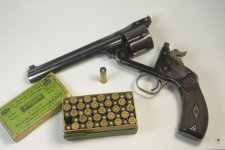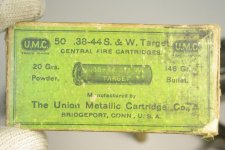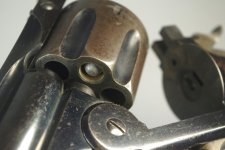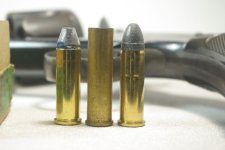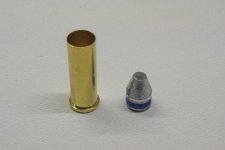Oldmanwesson
Member
I recently acquired a very nice antique S&W 38-44 Target revolver. I did a lot of research into making usable ammo for it and figured a specially loaded .38 Special cartridge with the bullet seated deep enough to clear the front of the cylinder ought to do just fine. So, I bought myself a little Lee Precision reloading kit, brass, primers, powder and bullets and started making some "samples". The .38 Special case is .004 narrower than the original .38-44 (not the one from the 1920's, but the one from 1887). The original .38-44 cartridge was as long as the cylinder (1 7/16 in) and the bullet was housed entirely within the shell, flush with the rim of the cartridge. The .38 Special is shorter, of course, and with a normally seated bullet is just a bit longer than the 1 7/16 cylinder, at 1.45 inches compared to the 1.437 of the cylinder. I made a handful of rounds seating the bullet to 1.43, and reducing the powder charge by about 10%. I tested the round in my 686-4 firing one factory load .38 Special and then one of my reduced loads. It worked just fine, and the softer recoil was noticeable. So, I tried the next cartridge in my 130-some year old target revolver and shot a bullseye at 20 yards. It was a beautiful, soft recoil, felt amazing to hold the old girl. Nice balance - better than the 686 I would say. Next shot however the bullet got stuck in the barrel so I thought perhaps my reduced loads were a bit too light. I drove the bullet out with a brass rod, made a few new rounds using the full .5cc scoop as per the instructions. Again, I tested it first in my 686, one factory load, one custom load. The difference between the two was less, but my .5cc charge still felt softer than the factory load. Time to test it in the old girl. Same thing: one fine shot right in the center, next shot the bullet got stuck again. I removed the bullet again, made a new powder measure about 10% above the .5cc Lee scoop and loaded a few more. Tested them with my 686 against factory loads and the difference was barely perceptible. I tried it in the 38-44 and the first two shots went fine. On the third shot the gun went just "poof" and I could tell that the bullet was stuck again. This time it went barely one inch into the barrel, and most of the powder had not even ignited! So, what am I doing wrong?? Is the diameter difference of the .38-44 against the .38 Special too much and the gas escapes backward instead of propelling the bullet? Is seating the bullet deeper than normal causing it to lose power? I do not crimp the case because of the extra depth, and also to prevent the case from splitting. I am using "American Select" powder and 105 grain SWC lead. Any thoughts??

